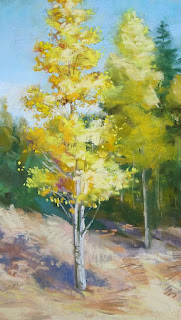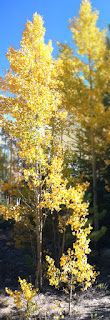 |
| Aspens, 12" x 7", pastel |
At last week's class we took a closer look at the anatomy of these lovely aspen trees, examined the bark a little, and discussed how to paint the light, leafy foliage and sky holes. Above you can see my demonstration painting, completed in the course of that day.

I cropped it and saturated the color of the original photo, blurring the
tree behind it so I wouldn't be tempted to paint too much detail there.
I removed the scanty little trees in the foreground, and reshaped the
foreground considerably, as you can see. I never meant to copy the
photo--in fact, it only launched my thinking and helped me to show the
students how to begin the drawing/painting process. Very soon I brought
to it the memory I have of the lively look of these lovely trees that
shimmer in the breezes. For the purposes of our demonstration I wanted
to draw near enough to show a bit about how to paint the bark and some
of the details of foliage.
My best advice, when painting taller trees particularly, is to find the entire outside geometric shape of the foliage and trunk. In this case I began with a long, slim oval. If a few leaves protrude beyond the edge of that initial shape it's no problem, but encompass the entire top-to-bottom, side-to-side shape in essence. In this case I let the treetop go off the page and shrunk the trees behind it for more of an organic sense of perspective.
The light colored bark is diagnostic, but please don't use too
much white to paint it. Find many colors that may be combined to create
'gray', the color that really best describes this bark, both in the
sunlight and shadow. Don't pick up your standard, everyday gray. Locate
the darker (
not black) striations in areas where there might be stress, such as where branches protrude or the tree flexes in the wind.
Foliage is open and leafy, with the 'balloons' often elongated and loose. (See the chapters on
how to paint trees and
how to paint foliage for further information.) Use a characteristic rounded shape to describe aspen leaves, utilizing the 'haiku' approach at the intersections of the balloons of foliage, the sky or background. Details should be implied, not over-described.The color of the foliage can be almost a rainbow, with emphasis on warm, pale yellows, oranges and greens. Flavor those colors with lavender or magenta underneath, to give *pop* to the colors, relying on the blue sky behind the oranges for the same.
Sky holes shouldn't be mechanical, large-medium-small holes where the balloons intersect, but should be well designed, rhythmic and visually interesting. These openings give the tree dimension and help to lead the eye around the tree. Smaller gaps are slightly darker in value (but the same color) as the sky, because of intervening small branches.
I hope everyone is having fun painting these colorful, lively trees.
Keep going, gang!
Deborah


